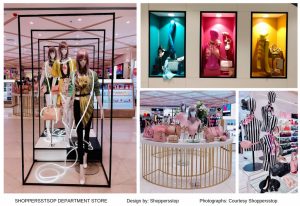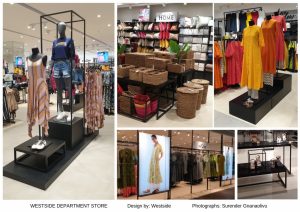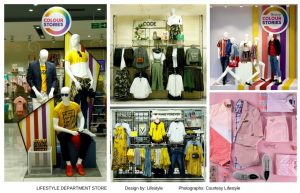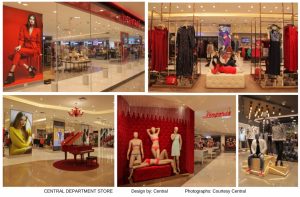Traditionally, regional Indian retailers have created iconic shopping destinations to serve generations of consumers across different economic strata. These “family stores,” as they are known, have dominated shopping high streets in select cities and towns with their sheer size and assortment in an assisted selling format, but with limited focus on offering a modern shopping experience.
The rapid growth of organized retailing and the evolution of the Indian fashion consumer has opened the door for institutionalized corporate department store chains to set shop. Today, the top four players operate a total of 350 stores occupying more than 15 million square feet across 80 cities in India and feature many national and international fashion brands for men, women and children.
The growth in the number of quality malls attracting premium footfalls has encouraged department stores to anchor them and evolve to stay relevant enough to survive the onslaught of online retail growth.. Interestingly, for global brands like Marks & Spencer, India is its second largest market after the U.K. with 76 stores across 32 cities. Despite each department store chain adding more than 20 stores every year, a decline in revenue growth rates has pushed them to invest in upgrading their store experience, e-commerce platforms and omnichannel enablement, in order to remain viable to the new-age, omnichannel-savvy Indian shopper. Here is a snapshot of the top four department store players in India.
SINCE 1991: SHOPPERS STOP
Shoppers Stop was founded in 1991 by the K. Raheja Corp. group of companies, one of India's biggest hospitality and real estate players. It also set up the first department store in India in 1991. Today it is a leading “bridge-to-luxury” department store chain of 83 stores across 38 Indian cities spread over a total of 4.5 million square feet, and reporting an annual topline of $270 million USD.
Recently, the company set out to update its in-store experience by reimagining its visual merchandising strategy and store design. After almost three decades of presenting itself as a family fashion destination, the brand today is repositioning itself as a young, trendy omnichannel destination for fashionistas. The store presentation is being actively rebooted with the use of art and styling in its windows and in-store focal point display schemes.
Advertisement

SINCE 1998: WESTSIDE
In 1998, Tata, the Indian multinational conglomerate, ventured into fashion retailing by acquiring the British department store Littlewoods that had set foot into Bangalore. Renamed Westside, today it has grown to 148 stores across 82 cities, occupying a total footprint of 3.5 million square feet, and delivering a reported turnover of $353 million USD. The store’s dominant private label brand portfolio contributes to 98 percent of its total sales, making it the most profitable department store chain in India. Westside recently updated its retail experience with a new environment and visual merchandising scheme that presents it as a young aspirational fashion destination relevant for the millennials. Styled mannequin groupings and fashion ensembles in a clean, modern environment present the retailer’s differentiated and aspirational fashion proposition with great clarity.

SINCE 1999: LIFESTYLE
Lifestyle department store made its debut in India from the Landmark group, the Dubai-based retail and hospitality conglomerate, in 1999. Known for its strength in merchandising, the store offers a curated portfolio of brands and private labels. The chain has 78 stores across 20 Indian cities spread over 3.5 million square feet. It delivers a topline of about $601 million USD. The brand embraced a heavy omnichannel strategy two years back, and today has integrated technology in store to enable self-checkout at different locations.
Advertisement
Recently, Lifestyle updated the in-store experience with a new store design that presents a stronger lineup of brands and categories than before. Visual merchandising is coordinated with marketing campaigns across the store and is integrated into stylized mannequin clusters with interesting uses of technology and signature kinetics in its display schemes.

SINCE 2004: CENTRAL DEPARTMENT STORE
Central Department Store was launched in 2004 from the house of Future Group, the leading Indian retail company that boasts of a wide portfolio of 1444 stores across various categories, and in 409 Indian cities. Today, 30 Central stores operate across 20 cities, occupy a total space of 3.4 million square feet, with a reported revenue of about $527 million USD.
The store was recently repositioned as a premium department store concept with sharp attention given to the brands offered, the store ambience, visual merchandising and the service for the discerning consumer. Visual merchandising and store design play a key role in this transformation with attention drawn to visual cues of a premium lifestyle articulated through props, styling, digital displays and a brand-proprietary signature red color palette.

Advertisement
As per the India Brand Equity Foundation (IBEF), demand for retail space in India is growing at a blistering pace of 81 percent, amounting to about 7.8 million square feet annually. This coupled with the growth of organized retail at 18 percent, as per AT Kearney analysis, is giving a long lease to the department store format in India, which seem to have succeeded in staying future proofed for now. The Indian consumer is sure to enjoy shopping in them for many more years to come.
Surender has more than two decades of experience in the Indian retail industry in retail strategy, store design, planning and development, retail marketing, visual merchandising, writing and academia. He’s held senior positions at leading retailers like Shoppers Stop, Reliance Retail, Mahindra Retail and as a senior retail consultant working with leading retailers and brands in India. Reach him at surenderg.retail@gmail.com.


 Photo Gallery1 week ago
Photo Gallery1 week ago
 Headlines3 days ago
Headlines3 days ago
 Headlines1 week ago
Headlines1 week ago
 Headlines1 week ago
Headlines1 week ago
 Designer Dozen2 weeks ago
Designer Dozen2 weeks ago
 Headlines1 week ago
Headlines1 week ago
 Designer Dozen6 days ago
Designer Dozen6 days ago
 Headlines1 week ago
Headlines1 week ago
























